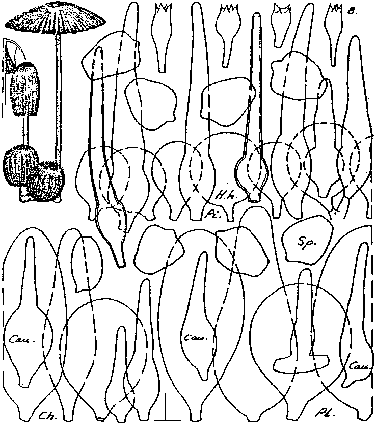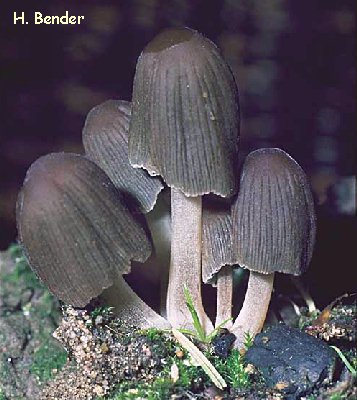Macroscopic features |
Closed pileus up to 20 x 15 mm, dark rust-brown to ochre-brown (Mu. 7.5 YR 3/6 to 6/6, K. & W. 6E7 to 5C/D7), remaining campanulate rather long, up to 30 mm in diam. when expanded. Lamellae narrowly adnate, rather broad and distant, white to blackish. Stipe 30-60 x 1-3 mm, usually relatively short, whitish, pubescent. |
Microscopic features |
Spores [40,2,2] 7.7-10.5 x 6.0-7.8 x c. 5.5 µm, av. L= 8.7-9.6, av. B= 6.8-7.2 µm, Q= 1.15-1.60, av. Q= 1.25-1.35, mitriform in front view, truncate; germ pore central, c. 1.8 µm wide. Basidia 15-36 x 8-10 µm, 4-spored. Pseudoparaphyses 4-6 per basidium. Cheilocystidia 30-80 x 25-40 µm, (sub)globose to narrowly ellipsoid, sometimes slightly utriform intermixed with lageniform ones, 30-60 x 8-20 µm, with tapering neck and 2-5 µm wide at apex. Pleurocystidia 60-100 (-120) x 25-60 µm, (sub)globose to ellipsoid or utriform. Pileocystidia 50-100 x 12-15 µm, lageniform with tapering neck, 3.5-6 µm wide at apex. Sclerocystidia present. Clamp-connections present. |
Habitat |
Gregarious, on burnt ground. Rather common. |
Remarks |
The peculiar shape of the spores makes this species easy to recognize. Macroscopically, the roundish shape of the young fruit-bodies, usually rather dark brown, and the habitat on burned places, are indications that one is dealing with this species. |

[Copyright © by Uljé]

[Copyright © by Hans Bender jbe8995374@aol.com]